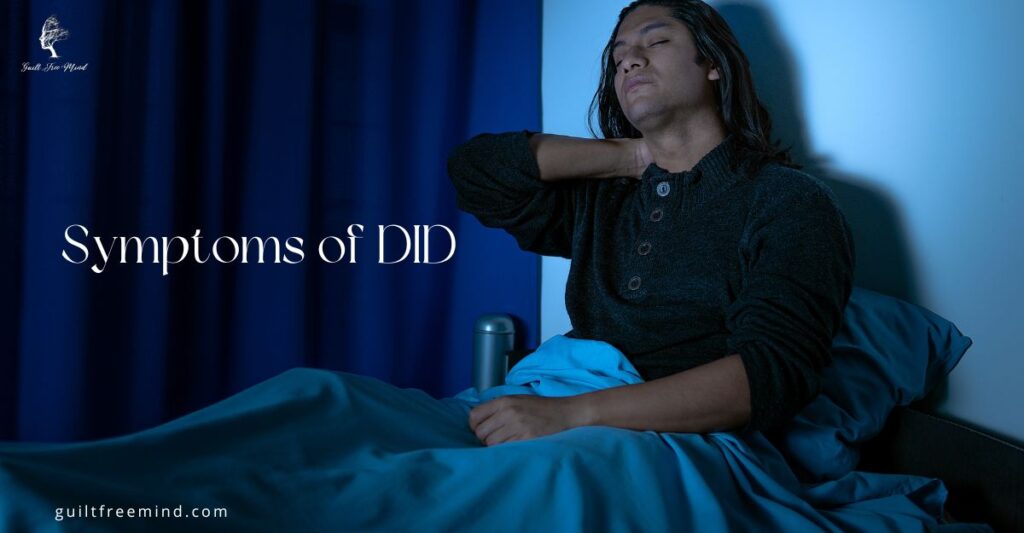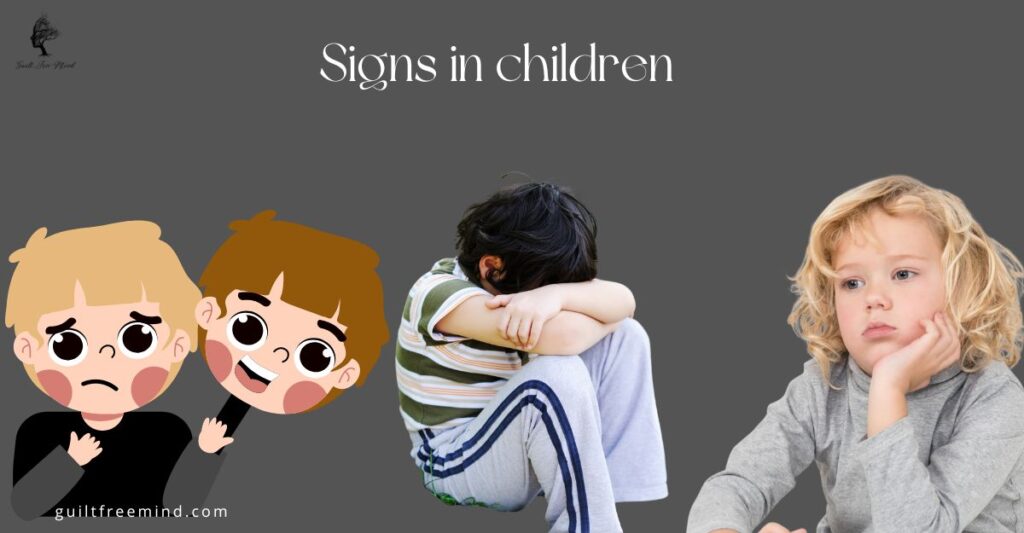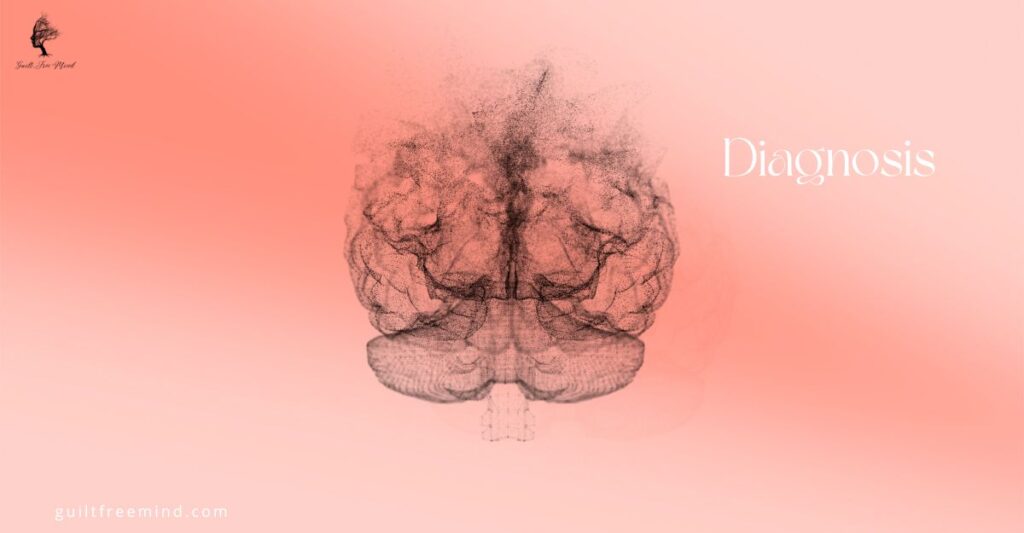Dissociative Identity Disorder (DID) is a complex and often misunderstood mental health condition. In this guide, I’ll explore the symptoms, causes, treatment options, diagnosis process, prognosis and myth debunking associated with DID. Whether you or a loved one has been diagnosed with DID, or you’re simply looking to learn more about this condition, this place will provide a comprehensive resource that sheds light on the realities of living with DID. First, let’s start with some basic information about what DID is and how it differs from other mental health conditions.

Table of Contents
Dissociative Identity Disorders
Until the year 1994, Dissociative Identity Disorder was referred to as split personality disorder. In the year 1994, the name was changed so that it can provide a better understanding of the actual condition. Most people think that those with DID generate new personalities that are completely different from their original personalities. However, that is not true. There is no growth or generation of new personalities in the individual. The personality of the individual undergoes splitting or fragmentation.
Understanding the alters
As I mentioned before, Dissociative Identity Disorder arises from the fragmentation of the individual’s personality. The own personality of the individual is referred to as the core personality. This fragmentation may give rise to 2 or more different personalities. Each of these different personalities will be referred to as alters. The primary identity of the individual that carries the individual’s name is generally guilty, depressed, dependent and passive.
When the switch happens from the current personality to one of the alters, the person’s behaviour, thought, process, feelings, et cetera may change completely. When one of the alters is in control, the person may display a different identity, self-image and history. A person who is originally a male may have a female altar which identifies with all the female characteristics. The name, gender, general knowledge, age, vocabulary, and mood of the altar may be a stark contrast to the person’s core personality.
How do the alters emerge?
The emergence of the alters depends on a variety of factors. However, certain specific types of stressors or circumstances can cause a specific alter to emerge. There is also a chance that the different alters may not be aware of the existence of other alters in the same individual.

Occurrence of Dissociative Identity Disorders
The idea is extremely rare in the general population. It has been observed if at around 0.01 to 1% of the population. There are no age, gender or cultural variations that may contribute to the development of this mental health condition. However, women have been observed to be more susceptible towards developing Dissociative Identity Disorder.
Understanding the symptoms of DID
As per the Diagnostic and statistical manual, the following are the criteria that an individual must meet to be diagnosed with DID.
Presence of different alters.
The person should show the presence of two or more distant individual identities. Each of these identities must have its perception, identification, methods, thought, processes, and behavioural patterns, which are different from the poor personality of the person.
- These alters will show a difference in the understanding of self, consciousness, perception, motor function, memory, behaviour, self-identity etc.
- The person with DID may also show dissociative amnesia. There may be frequent gaps in the person’s memory regarding their past. They may not remember certain aspects of their personal history like events, places, and people. This memory gap occurs in the recent and distant past. These gaps are not consistent with normal forgetting patterns.
- The presence of the alters is causing a significant level of impairment and distress to the person.
- Presence of out-of-character behaviour due to the presence of multiple identities in the same individual.
Certain other common symptoms in the case of DID are:
- Dissociative fugue states or situations where you travel to places, but have no memory of the same.
- Blank spaces in your memory. You are unable to recall important events from your adult or childhood life.
- Gaps in memory are like you cannot remember what you did yesterday, or you have time gaps in recent days.
- Feeling like you are constantly looking at yourself from the outside.
- Feel that your body is morphing into different sizes, and you have no control over it.
- Dreamy and vague memories related to experiences that took place in real life.
- Constantly feeling as if the thoughts, feelings and sensations, going on in your body, do not belong to you. You have no control over them.
- Noticeable changes in behaviour observed by others.

A person who suffers from DID doesn’t need to recognise all the signs on their own. Many times when the other alternate identities take over, they leave no memory of their existence. This makes it very hard for the person with DID to identify that something is wrong. All they know is that they have lapses in their memory. But, others may describe noticing changes like a different language, complete behavioural change, and change in an accent that comes and goes.
Other Signs and symptoms that may be observed in the case of Dissociative Identity Disorders
Occurrence of new behavioural patterns.
One day, you notice that you are wearing clothes that you hate. They are not the right colour or size and you don’t have any idea when you purchased those clothes. You try to figure out how you landed up wearing them. However, you have no memory or recollection of the events. You have no idea of what you did throughout the day before you realised that you were wearing clothes that are not of your style.
Changes in food preferences.
You go down for breakfast, and your mom has made you stuff you don’t like. When you enquire her about the same, she says that you asked her to make it for you. Again, you are memory draws a blank when you try to figure out when you asked your mom to cook you a breakfast that you hate.
Sudden new fears.
You are sitting with your group of friends. Suddenly a friend tells you, “I was not aware that you are afraid of insects”. You counter by saying, “I am not!” Your friend says, “You are!. A couple of days back when we were out shopping, you saw an insect on the side of the road and you completely freaked out.”
You feel completely stunned. You never had a fear of insects. What is more absurd is that you don’t have any recollection or memory of the event when you went out shopping with your friend.

Blurry identities.
In some cases, the identities are not aware of one another. It has been observed that the different alters show identities that are somewhat similar. These identities share some common traits. Thus, it is not a complete identity shift. You may be aware of one another.
Having blurred identities means that in your head, you will hear the voices and inputs from all your other alters. You will be able to hear their viewpoint their likes, just likes, hobbies, behavioural traits, etc. Suppose you are discussing a matter with your friend. In your head, you will be able to hear the opinions of all your alters.
There is also a chance that all these voices talk inside your head at one moment. They all want to be a part of the discussion you’re having and they all want their voices to be heard. It may feel that the different identities are battling with one another and trying to gain centre stage. If this happens, it can be very confusing and overwhelming for the person.
Signs and symptoms of Dissociative identity Disorders in the case of children.
- Having depressing and distressing memories and dreams.
- Complete zoning out. This is the cause of dissociating from the present.
- Common actions trigger mental distress in the child and remind them of trauma.
- The physical reaction towards the past trauma or memories like seizures.
- Showing unexplained changes in terms of activity, preferences and food.

The emergence of alters.
The alters may emerge depending on the circumstance the person is facing. Usually, the transition from one specific identity to another gets triggered when there is emotional stress. If you have completely separate alters in you, these alternate identities will be visible to the people around you. In case you have overlapping identities, there is a chance that your change in identity may go unnoticed by others.
Many times, those with DID me say that they feel as if they have suddenly become separated from their mind, body and actions. They may also report that they hear voices in their head. This voice may be a child’s voice, an adult’s voice, a female voice etc. Some people have reported hearing spiritual voices too. In certain cases, the different voices may be talking about different thoughts and make it very confusing for the person to understand even one thought properly. During such situations, the person may feel that they have no control over what’s going on in their mind.
There is a chance that the person may also feel strong emotions or certain impulses that they do not have any ownership over. As I mentioned before, they may start feeling that their bodies have suddenly changed shape, or there is a difference in attitude or preference for a while before it comes back to normal.
Causes behind dissociative identity disorder.
In the case of those who suffer from extreme trauma and stress, detachment or dissociation is a pretty common coping mechanism. Dissociation mostly starts during the childhood stages of an individual. It is one of the three different forms of dissociation which I have discussed in my previous blog post. In certain cases, dissociation may eventually lead to dissociated identity disorder. In other cases, they may develop dissociative amnesia or depersonalisation and derealisation disorder. Why someone specifically develops dissociative identity disorder is not known yet.

In most cases, those who suffer from DID have experienced severe sexual and physical abuse during their childhood. There is no dependency on age, social background, gender or ethnicity when it comes to developing DID. However, there is one significant risk factor. As I mentioned before, it is sexual, physical or emotional abuse during the early stages. Most often, those who suffer from DID have post-traumatic symptoms or post-traumatic stress disorder. Many studies suggest that DID is observed more in biological relatives of DID victims.
Conditions associated with DID
There are a few mental health disorders that are similar to DID. These may occur along with DID or show symptoms similar to DID. Most such disorders include.
- Depersonalisation
- Depression.
- Distress
- Dissociative amnesia
- Acute stress disorder.
Other psychiatric illnesses that may occur along with DID
Besides, split personalities, depersonalisation, and dissociation, those suffering from dissociative disorders may also show signs of other psychiatric problems like:
- Mood swings
- Sleep disorders like night, terrors, insomnia, or sleepwalking.
- Depression.
- Panic attacks.
- Phobias.
- Anxiety.
- Rituals and compulsions
- Eating disorders.
- Alcohol and drug use
- Psychotic-like sometimes (visual and auditory hallucinations)
- Self-harm
- Suicidal thoughts.

Diagnosis of Dissociative Identity Disorder
The diagnosis of DID in the case of both kids and adults is made using the criteria present in the diagnostic and statistical manual of mental disorders (DSM-five)
Besides asking the person about their symptoms, the doctor or therapist will also consult with the caregiver regarding the symptoms and alters that the person may have exhibited.
For diagnosing a person with DID, the person should exhibit the following signs.
• Presence of two or more personalities. These personalities should disrupt the person’s behaviour, memory, cognition, perception, awareness, or senses.
• Presence of gaps in the memory regarding everyday events and personal information. These gaps may also be related to traumatic events that occurred in the past.
• Symptoms that cause severe distress in performing in social and work environments.
• Disturbances that are not a part of any religious or cultural practice. For example, a child says that they have a friend whom no one else can see.
• Exhibiting chaotic behaviour and suffering from amnesia not caused by drug or alcohol use.
• Changes in sense of self or identity. This will be marked by the presence of two different personality states. Others may recognise these changes in terms of different behaviour, speech or attitude.
• Trouble recalling life, events, personal details or how to perform simple tasks.
• Constant presence of emotional distress because of the symptoms.
Before DID has been diagnosed in the individual, the mental health practitioner will ask the person to get checked by a physician. This is done to rule out any underlying medical condition like seizure disorders, substance abuse and psychosis.
In the case of children, first, the physician will rule out the age, appropriate fantasy play and imaginary friends before diagnosing the child as having DID.
Controversy
There is a constant controversy going on about DID, some mental health practitioners do not even recognise DID as a mental health disorder despite having a place in the DSM5 menu. Because of this, many patients have to live with the condition for years before they can get the correct diagnosis. As I mentioned before, for a diagnosis, the DSM-5 manual is used along with a psychological test like the Rorschach inkblot method.

Is the condition curable?
So far, there has been no cure identified for dissociative identity disorder. Many mental health practitioners think that it is just a myth. No disorder like this exists. However, if the person is properly diagnosed, the therapist can help them improve their symptoms and allow them to gain control over their sense of self and life.
Treatment options for Dissociative Identity Disorder
A trained therapist will understand, communicate, recognise and support all of the identities present in the individual. This way, the person can start to manage their distress without having to change their identity state.
The primary goals of therapy in the case of DID include:
- Recognising and reframing the cognitive distortions present.
- Integrating alternative identities in the person.
- Identifying and understanding the past traumas that may have contributed to the condition.
- Treating the other mental health symptoms that may be co-occurring
Recommended therapy approaches for the treatment of DID.
Cognitive behavioural therapy (CBT).
CBT can help a person understand their emotions. It can also help the therapist guide the individual towards recognising the negative thought patterns and turning them into positive ones. This can go a long way in helping the person lead a more fulfilling life.
Dialectical behavioural therapy
This therapy is used with those individuals who experience very strong emotions. This form of therapy focuses on helping the person accept the reality of their condition. Following this, the therapist helps the person change their life for the better. The target is to modify unhelpful behaviours and bring in more beneficial behavioural patterns.
Eye movement, desensitisation and reprocessing (EMDR) therapy.
A movement, desensitisation and reprocessing or EMDR therapy as it is otherwise known as focuses on changing the viewpoint of the mind towards the past trauma. Instead of thinking, why did I have to go through this, EMDR makes people feel that we are survivors and strong individuals to have survived the trauma. In EMDR, the primary focus is on eye movement when the person is experiencing or remembering past trauma.
Psychotherapy or talk therapy
- Talk therapy primarily focuses on.
- Educating a person about the condition that they are facing.
- Increasing their awareness and tolerance towards their own emotions.
- Helping the person get control over their impulses.
- Preventing dissociation in the present and future
- Managing their current relationship, daily functioning and stressors.
A few studies have shown that those people who received continuous treatment showed significant improvement over time.
Adjunctive therapy:
Adjunctive therapies include other forms of therapies like art therapy, movement therapy etc. These therapies allow people to connect the different areas of their minds that have been shut off because of the presence of past trauma. These therapies are mostly conducted in the therapist’s office which is a low-stress environment for the patient.

The primary aim of these different forms of therapy is to help the different personalities in the person live together in harmony. The therapist also helps the patient figure out what triggers the different alters to come out and take the centre stage. Once the person understands the triggers, they can work to avoid them, so that all those do not make a sudden appearance.
Hypnotic therapy.
In some cases, mental health practitioners, also recommend the patient undergo hypnosis. The reason behind this is hypnosis when combined with psychotherapy can help the person recover refreshed memories. When the person is under the influence of hypnotic therapy, they are also more open to accepting suggestions from others and imbibing them in their day-to-day lives.
Medication.
There are no specific medications that can treat dissociative identity disorder. However, your psychiatrist may suggest medication to help you deal with the severe symptoms of depression and anxiety. The presence of anxiety and depression can make treatment of DID very difficult. Therefore, these need to be tackled first.
Is there a way to prevent Dissociative Identity Disorder?
Unfortunately, so far, there is no way to prevent DID. However, if you identify the signs early on and get treatment, you can manage the symptoms very easily. Teachers, caregivers, and parents should also watch for signs in case of young children. If your child has been through trauma, provide them therapy as soon as possible. This can mitigate the risk of developing DID in future.
Treatment will also help you identify the triggers that lead to personality changes. Some of the common triggers are high levels of stress. Managing your stress levels, meditating, using art therapy to keep your mind in a balanced state and avoiding drugs and alcohol can help reduce the chances of your alters taking over.
Living with DID.
Those who have DID say that they have multiple personalities or alters. DID has a huge impact on the person’s relationship, mental health, work-life balance etc. Living with this kind of mental health condition can be pretty scary, frustrating and difficult. In most cases, people do not get diagnosed till they become adults. Therefore, they may have years of terrifying experience under their belt.

There is also a chance that different personalities may not gel well with one another. When a different personality takes hold, the person may wake up at a place they have never been before and with no memory of how they landed up there in the first place.
In other cases, it has been seen that the personalities get along with each other. This helps the person deal with the situations of everyday life easier. In certain cases, such people also suffer from social stigma. This is because most of the knowledge about DID comes from movies or fiction. The consensus is that those with DIDs have violent alternate personalities. However, this was not true. Very rarely has it been seen that DID patients exhibit violent behaviour.
Breaking down the stigma regarding Dissociative Identity Disorder.
Just like other mental health issues, DID has its own share of stigma and myths associated with it. Let’s break down some of them.
Presence of a violent altar.
Those who have DID do not have alternate personalities that are violent. There is little to no evidence to suggest this behavioural pattern. It is true that people with DID may be more inclined towards self-harm and suicidal thoughts. However, this does not mean that they will harm others. They are more inclined towards harming themselves.
Opposite personalities.
Movies make us think that people with DID have alters that are completely different from each other. However, that is not the case. There is usually a shift in the personality but not a complete 360° change. The differences in personality changes are most often subtle. Therefore, most people may not even notice the change. The presence of the opposite personality may happen in certain cases. However, there is no proof that it will happen in every case.
Very rare.
DID has a prevalence of around 1.1 to 1.5% in the general population. Therefore, it is not that rare.

Supernatural or being possessed
Certain forms of religious beliefs say that a person who has Dissociative Identity Disorder has been possessed by a Demon or a ghost. This is completely baseless. Dissociative Identity Disorder is a mental health condition. It has got nothing to do with one’s cultural or spiritual beliefs. As per DSM-5, the identities that exhibit spiritual or supernatural behaviour are referred to as possession-form identities. A person will be diagnosed with possession-form identities when:
• The changes in identity are unwanted.
•Alter or the other identity’s presence causes severe distress to the individual.
• Identity shift leads to memory lapse and amnesia.
Conclusion.
Dissociative Identity Disorder starts off as a coping mechanism when a person faces severe emotional, sexual or physical trauma. However, it can soon turn into a real mental health condition. If you or your loved one is showing identity shifts, memory gaps, presence of different behavioural patterns that don’t match up with one another, you should help them get to a mental health professional. There is no treatment for DID. However, the different forms of therapy like talk therapy, hypnotic therapy, adjunctive therapy etc. may make a huge difference and allow a person to manage their symptoms and allow them to lead a more fulfilling life.
If you want to know more about other personality disorders, how to lead a more productive and positive life etc. please subscribe to Guilt Free Mind. The subscription option is present in the sidebar. If you subscribe, I can notify you about the release of the new blog posts. In case you like watching videos, subscribe to the YouTube channel of Guilt Free Mind. Feel reach to reach out to me via the comment section. You can also join me on Twitch if you want to boost productivity. I do study sessions every day from 11 am to 7 pm IST. Having a study buddy can help you focus better.
See you in my next blog post

1 Comment
hello!,I really like your writing so a lot! share we keep up a correspondence extra approximately your post on AOL? I need an expert in this house to unravel my problem. May be that is you! Taking a look ahead to see you.